Los Chucaquis Pétillant-Naturel Champelli
Villa di Corlo – Rosato Lambrusco di Sorbara Rolfshark
Stefan rosner Gruner veltliner Hauswein
durante family pinot grigio la spinee
Poli île de beauté rosé Sciaccarellu-Nielluccio
Capezzana Carmigiano Barco Reale
durante family cabernet la spinee
Luna Benegas Cabernet Sauvignon
Diego Conterno Nascetta
Moulin de la Roque Bandol Rosé Les Hauts de Vallon
BloodRoot sonoma county Pinot Noir
Clos de Caillou Côtes de Rhône VIEILLES VIGNES
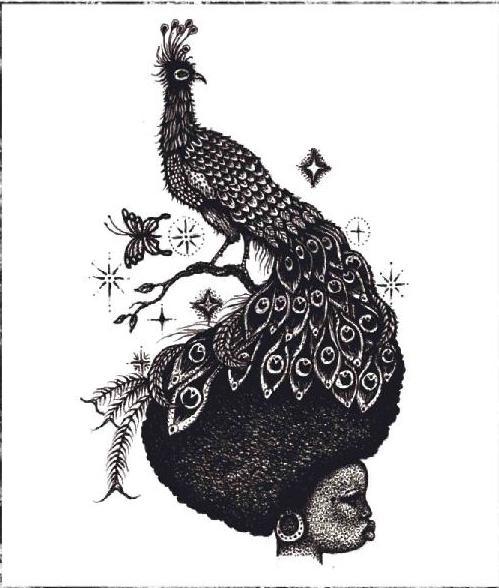 Los Chucaquis Pétillant-Naturel Champelli (Sparkling Albariño) – Organic, Biodynamic and Natural
Los Chucaquis Pétillant-Naturel Champelli (Sparkling Albariño) – Organic, Biodynamic and Natural
Jehan Hakimian is one of the coolest and friendliest guys I know. Wine-wise, he started out as a clerk at The Spanish Table, got a gig selling wine for a few small indie distributors, parlayed that into a national sales job for a large company’s Iberian and Latin American portfolio, became the national sales guy for a cool organic wine company, and now reps another great wine company’s West Coast sales while handling all sales for Stirm Wine Company.
In his spare time, he formed a wine project with Ryan Stirm of Stirm Wines to make some great natty wines from small vineyard sites on the Central Coast, called Los Chucaquis.
Their inaugural wine has won over my heart and taste buds: a sparkling Pét-Nat Albariño he calls Champelli.
Organic. 100% Albariño from the C5 vineyard in Santa Ynez. After nighttime harvest, the grapes were direct pressed, then fermented warm to dryness. A portion of the juice was reserved, frozen, and later added to the finished wine, and bottled the next day to get the ferment going again. It was then given three months’ of bottle aging to finish the secondary fermentation – very much like the col fondo method of making sparkling in the Emilia-Romagna region of Italy. Unfined, unfiltered, no sulfur added, and undisgorged. Jehan and Ryan describe this wine as being made “via simple methods,” resulting in a foamy, fritzy wine that shouldn’t be mistaken for intense bubbly like Prosecco.
Light bodied, tangy acidity, crisp and dry. With a low 11.5% ABV it is great for refreshment and all-day sipping!
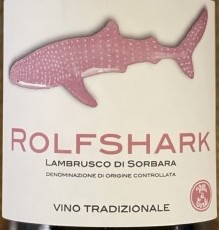 Villa di Corlo – Rosato Lambrusco di Sorbara Rolfshark– Organic
Villa di Corlo – Rosato Lambrusco di Sorbara Rolfshark– Organic
Lambrusco is both the name for a family of grapes native to the Emilia-Romano and (to a lesser extent) Lombardy regions of Italy and for the lightly sparkling (frizzante) wine made from those grapes. It can be vinified from bone dry to sweet, and is a perfect accompaniment to the foods of the region, especially Ragu, Prosciutto, Salume, and Pizza..
There are more than 60 identified varieties of the grape, although it’s generally produced from several common varieties: Lambrusco Grasparossa, Lambrusco Maestri, Lambrusco Marani, Lambrusco Montericco, Lambrusco Salamino and Lambrusco Sorbara.
It’s produced in northern Italy, predominantly in Emilia-Romagna; the grapes grown for Lambrusco production come from four different zones: Modena, Parma, Reggio-Emilia and Mantua, the last of which is located in Lombardy. There are eight Lambrusco denominazione di origine controllata (DOC) regions: Colli di Parma Lambrusco, Lambrusco Grasparossa di Castelvetro, Lambrusco di Sorbara, Lambrusco Salamino di Santa Croce, Reggiano Lambrusco, Colli di Scandiano e Canossa Lambrusco, Modena Lambrusco, and Lambrusco Mantovano.
In the US, Lambrusco’s reputation was ruined by the import of a highly advertised and treacly version from Riunite, and many consumers still turn their noses up at the idea of tasting Lambrusco. But dry Lambruscos are amazing and are the perfect foil.
Lambrusco Sorbrara is lightly colored, fragrant and boasting vibrant acidity, Lambrusco di Sorbara, made from the grape of the same name, is the most refined wine of the Lambrusco category. Made around the village of Sorbara north of Modena, the variety excels in the sandy, fertile plains between the Secchia and Panaro rivers.
Historically, Lambrusco di Sorbara was a dry, crisp wine that finished its fermentation in the bottle to produce a light effervescence.
Antonia Munari owns and operates VIlla di Corlo, a family estate in the plains 15 minutes southwest of Modena. It is one of the region’s few properties that is genuinely dedicated to pushing the envelope with organic farming. Furthermore, the entire winery is solar-powered and carbon neutral, vineyards are either certified or in-conversion to organics, and there is concerted, consistent effort to take the entire operation in an ever more “green” direction.
Antonia farms the gamut of Lambrusco sub-varieties and bottles wine under multiple appellations, but the focus is always the same: juicy, clean, user-friendly “restaurant-style” Lambrusco intended to be glugged back in between mouthfuls of prosciutto and pizza.
The “Rolfshark” brand is named after Rolf Kielman who produced the watercolor painting that is depicted on the label. He is the eco-architect who designed the Ben & Jerry’s Factory along with many other eco-friendly properties.
Here we have a perfectly refreshing Lambrusco for the summer; Rolfshark Rosato Lambrusco di Sorbara. This is the lightest, most floral, and most delicate of the Lambrusco family. Produced as a Rosato with fizzy bubbles that tickle the nose and a dry palate with just the right balance of ripe fruit. Perfect for a day by the pool, for your charcuterie platter, or pair with any spicy dish that needs a little cooling.
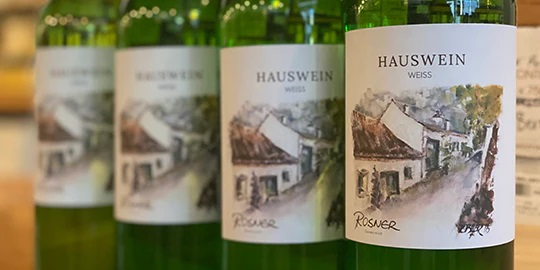 weingut Stefan rosner Gruner veltliner Hauswein – Organic
weingut Stefan rosner Gruner veltliner Hauswein – Organic
It’s no stretch to say that Stefan Rosner is a rising star on the Austrian wine scene. Having recently taken over the reins from his father Norbert, who converted the vineyards to organic farming,Stefan works in a tiny underground cellar that is cut into the stone beneath one of the oldest vineyards in Langenlois, Austria (one of a handful that Stefan’s family has been farming since the late1800s).
Just a few steps from well-known neighbors like Brundlmayer, Stefan produces wine in an impressive diversity of styles: from the angular freshness of his screw-cap Gruner, Rose’, and Zweigelt, to the savory skin-fermented “Wildrose” whites, up to the startlingly deep and layered “reserve” level Rieslings, Grüners and varietal reds from single crus. Extremely attentive farming, straight-shooting, and open/warm-hearted people.
Stefan notes that “our vineyards are free from chemical fertilizers and herbicides due to the great work of my father for more than a decade now (Certified Organic since 2010). It is important for me to also pursue a more natural approach during processing and fermenting of the wines.” And those philosophies are evident in today’s liter of Grüner Veltliner. Although labeled as a generic “landwein,” this is anything but as it is a masterful blend of their premier, organically farmed vineyard sites, from the 2021 vintage. In the winery, it’s all about a quick, natural process: unmanipulated fermentation and a brief stainless steel maturation on lees.
Stefan Rosner’s liter of Grüner is delicious and thirst-quenching, all while retaining the hallmarks of this über-classic Austrian grape. It cascades out of the bottle with unrivaled freshness and a dazzling mixture of zesty citrus, light spice, damp white flowers, arugula, white pepper, and beautifully ripe green apple. This is unequivocally pure, deeply refreshing Grüner Veltliner with organic grapes, moderate alcohol, and an unadulterated process in the cellar, it’s also a liberating, guilt-free drinking experience!
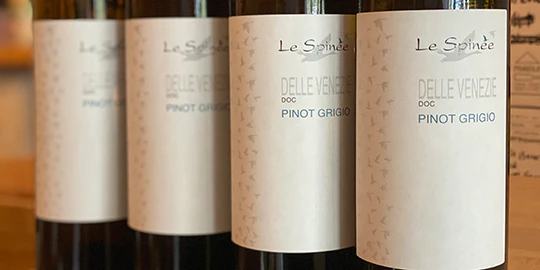 durante family pinot grigio la spinee- organic and biodynamic
durante family pinot grigio la spinee- organic and biodynamic
The Durante Family Estate is based in the Piave DOC in Northeastern Italy. This is a region more known for Prosecco, and the still wines rarely make it out of Italy.
Father Lino and his sons Ivano and Michele Durante pour their hearts and souls into their small family farm. Certified organic and practicing biodynamic since 1998, the trio believes that farming this way produces better wines.
There are oceans of bland and boring Italian Pinot Grigio wines out there, but this puppy stands in stark contrast to the Santa Margheritas of the world. Fermented with native yeasts on the skins, this one offers up bold and exotic aromatics, a rich texture, and an orange wine-like style.
From a tiny, certified organic and practicing biodynamic, family-run estate in NE Italy, this is brand new to the United States. Fermented naturally with native yeasts and minimal sulfite additions, this is Pinot Grigio with bold, savory, and kind of funky aromas and flavors that we love.
This is not your typical Pinot Grigio! It will appeal to lovers of natural and/or orange wines, and it does see a bit of skin contact. The resulting wine kind of “walks on the wild side.” Aromas and flavors of ripe apple, peach skin, musky herbs, and orange blossom lead to a rich yet lively palate. Enjoy with pho or other savory and umami dishes.
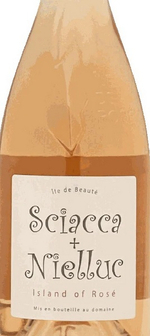 domaine eric Poli île de beauté rosé Sciacca+Nielluc – practicing organic
domaine eric Poli île de beauté rosé Sciacca+Nielluc – practicing organic
In 2005, Eric Poli sold his interest in the family’s 75-acre Vin de Corse estate, Domaine de Piana, to his brother Antoine. With the proceeds, he bought seven acres of old-vine Niellucio and Vermentino (aka Malvoisie de Corse) on the terraced Poggio d’Oletta in the heart of Patrimonio, the oldest and arguably best appellation on this mountainous Mediterranean island. An important factor in Eric’s decision was the fact that his wife, Marie-Brigitte, is the owner of Clos Teddi, the Patrimonio Domaine founded by her father in 1970.
Eric expanded Clos Alivu’s modest holdings with the purchase of an additional four acres of vines in the commune of Santo Pietro di Tenda in 2012. Today, he manages Clos Alivu’s 12 acres of vines and the 86 acres of Clos Teddi.
Eric has also assumed responsibility for the winemaking of both domains, while Marie-Brigitte handles commercial affairs for the two companies. The brands are marketed separately outside of Corsica, but at home, the Polis share a popular retail tasting room in the heart of the picturesque harbor village of Saint-Florent where they showcase the wines of both Patrimonio domains. The boutique also features a full range of IGP Île de Beauté wines made from the 108 acres of vines Eric planted in 2007 near his hometown of Linguizzetta on the east coast of the island.
Protected by the maritime influences of the Golfe de Saint-Florent, vines cultivated on the limestone soils of Patrimonio’s hillsides rarely require treatments of any kind, so Eric’s practices are essentially organic (though without certification). Niellucio, genetically linked to Sangiovese, thrives in this ideally situated inlet at the north end of the island, and when yields are limited, results in wines with more freshness and finesse than those made from its Tuscan cousin. Corsica’s secondary red grape, Sciaccarellu, is the descendant of another Tuscan variety, Mammolo, which was likely introduced while the island was under the control of the Republic of Pisa (1077-1284). Primarily a blending grape for red wines, it can result in high-toned, floral, and fruity rosés on its own.Also, the fresh, aromatic whites made from Vermentino rival the best of Sardinia, Corsica’s neighbor to the south.
This wine is so aromatic you could put a dab behind your ears. Wild wind-blown lavender, with dried strawberry, rosemary, and grapefruit; very juicy, ultra-fresh, and terrifyingly easy to drink —- cool and racy and, did I say juicy?
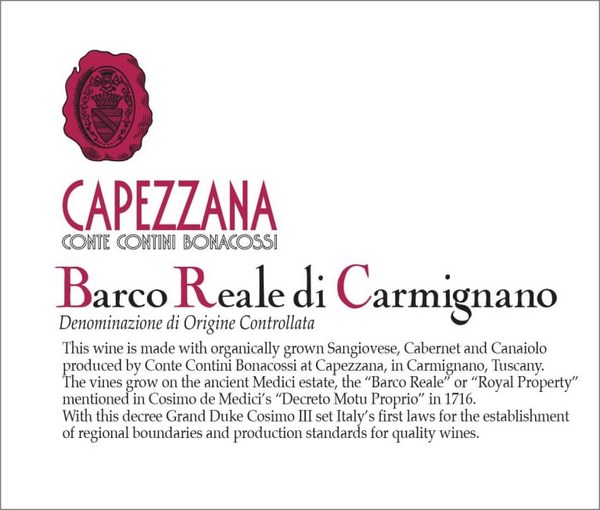 Capezzana Carmigiano DOCG Barco di Reale (Organic)
Capezzana Carmigiano DOCG Barco di Reale (Organic)
Did you know that Cabernet Sauvignon has been grown in Tuscany since the 18th century? Carmignano is one of the lesser-known DOCG wines made in the famous Tuscany wine region of central Italy. The wine’s origins can be traced back as far as the 14th Century, when, in 1369, a document was drawn up demonstrating that Carmignano was four times as expensive as any other wine of the time. In the early 1700s, the Grand Duke Cosimo III de Medici established the area of Carmignano as a nursery for grape varieties, which included the planting of internationally renowned Cabernet Sauvignon imported from France. He also issued a decree controlling the wine’s production standards and sales, enforced by the Congregazione di Vigilanza.
Carmignano, the village from which the DOCG takes its name, lies 12 miles west of Firenze (aka Florence), on the eastern slopes of Monte Albano. It was one of Italy’s earliest regulated wine names, long before the country’s DOC/G system was introduced in the late 1960s. Despite this historical precedent, Carmignano wines were absorbed into the Chianti title (which was more prestigious at that time) and sold as Chianti Montalbano.
It was not until 1975, after much campaigning and determined action by several Carmignano vignerons, that Carmignano was granted its own independent DOC. The efforts were doubly repaid in October 1990 when the title was promoted to full DOCG status.
Carmignano wines are dry reds based on a standard modern Tuscan blend of Sangiovese (at least 50% of the final blend), Canaiolo Nero (up to 20%), Cabernet Sauvignon and Cabernet Franc (10–20% each). The wine is similar in style to its more famous cousin (and neighbor) Chianti, which may now also be made using a portion of Cabernet Sauvignon.
Carmignano wines are produced from vineyards in and around the villages of Poggio a Caiano and Carmignano. The terroir here is ideal for quality viticulture, and particularly for Sangiovese thanks to its lime-rich, free-draining soils, hot days, and cool nights. The delimited Carmignano viticultural area also produces Barco Reale di Carmignano, a more youthful version of the robust red Carmignano.
The region’s largest winery is Tenuta di Capezzana, which accounts for over 70% of DOCG Carmignano produced. This historic wine estate can trace its wine production all the way back to 804, with the addition of Cabernet Sauvignon being made in the 16th century.
Capezzana’s version is an organically farmed blend of primarily Sangiovese (75%), with 15% Cabernet Sauvignon, 5% each of Canaiolo and Cabernet Franc, fermented spontaneouly with indigenous yeasts, fermented in stainless steel and aged for three months in five-30 year old large (550 gallon) neutral Slavonian or Allier barrels.
Barco Reale takes its name from the Medici property at nearby Artimino whose boundaries were defined by the ‘wall of the Barco Reale’ (Royal Reserve) which ran for more than 30 Roman miles.
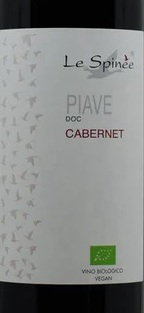 durante family piave doc cabernet la spinee – organic
durante family piave doc cabernet la spinee – organic
The Durante Family Estate is based in the Piave DOC in Northeastern Italy. This is a region more known for Prosecco, and the still wines rarely make it out of Italy.
Father Lino and his sons Ivano and Michele Durante pour their hearts and souls into their small family farm. Certified organic and practicing biodynamic since 1998, the trio believes that farming this way produces better wines.
Piave may be better known for the cheese by the same name, but this 85% Cabernet Sauvignon and 15% Cabernet Franc blend could be the new superstar. Cabernet Sauvignon and friends (Carmenère, Merlot, Cab Franc) have been planted in the Veneto since the 1830s and took on even greater importance with the onset of phylloxera.
Tank fermented in steel on native yeast, and aged in tank before bottling. Look for red and black fruit notes of raspberry, blackberry, and red currant. It’s big, bold, and deserves to be paired with grilled meats.
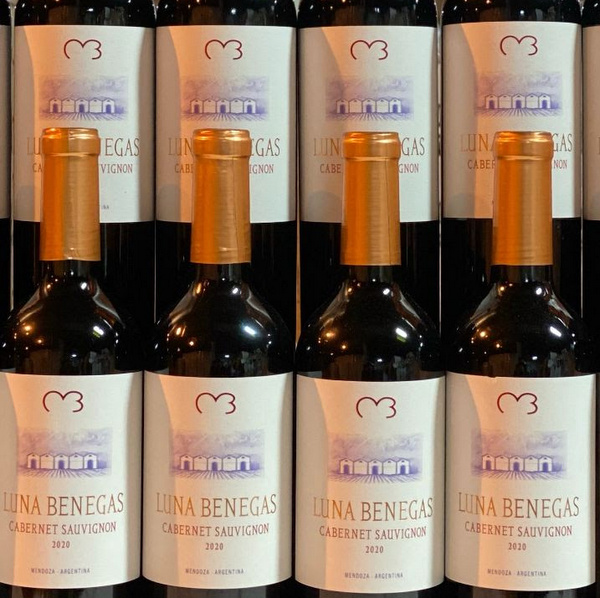 luna Benegas Cabernet Sauvignon – sustainable
luna Benegas Cabernet Sauvignon – sustainable
Tiburcio Benegas, together with Silvestre Ochagavía (Chile) and Agoston Harszthy (California), are considered the first three pioneers in the wine industry in America. Convinced that it was imperative to achieve excellence in their products, Benegas brought the first French grapevines ever introduced in Argentina, along with the most advanced technology available at the time
Pedro and Alberto Benegas continued with the family enterprise, following Tiburcio´s steps. Pedro, who had studied enology in Bordeaux, gave the rising industry a new boost at the beginning of the century. He stayed at his father´s and in Mendoza in charge of the vineyards and the winery, while Alberto, his brother, organized the administration and marketing of the wines throughout the country, from Buenos Aires. Thus, Benegas Hnos. was founded in 1908, starting a lineage that would last up to the present. After a trip to France, Pedro Benegas came back with a more comprehensive and modern view regarding the management of vineyards and quality winemaking. Until then, the Trapiche wines were made with some sophistication but fell short of the expectations aimed at by the Benegas. Pedro and Alberto decided to incorporate new brands for more demanding consumers, so they began to produce Fond de Cave, Broquel, Puente Viejo, and Vezelay. Pedro Benegas incorporated the typical features of the Bordeaux wines and the blends were definitely inspired by French tradition
Pedro Benegas died in 1943 and his nephew, Federico A. Benegas Lynch (1916-1997), who had joined the company in 1938, settled in “El Trapiche”, Mendoza, to work in the winery. At the beginning of the 70’s, the family company dissolved and the assets were sold. The Trapiche winery was demolished, and the vineyards were divided and sold. Pulenta bought the wine brands and Seagrams, the champagne brands. The only one that remained in the family was BENEGAS, owned at present by Federico J. Benegas Lynch.
Federico J. Benegas Lynch was born in the winery in 1951. He grew up by his father’s side, sampling wines and working in the vineyard. This atmosphere awakened in him a deep love for his land and its wine. He had always been close to his father and eventually, he joined the enterprise, doing what he loved most with a solid conviction. In 1997, he became a member of the Board of Directors of Peñaflor and Trapiche wineries, which were then under the control of Luis A. Pulenta and DLJ. He resigned to his position in March 2001.
It was in 1998 that Federico J. resumed his activity as winemaker when he settled on the 40 hectares of Finca Libertad, part of the old Benegas’ family property, where the vineyards are 20 to 80 years old. He started the production of quality wines, fully convinced that he would achieve the level of excellence of his ancestors. This restoration period is the landmark of the beginning of a new era in the Benegas family, who had always devoted to the art of vines from the very roots
100% Cabernet Sauvignon from younger parcels of Finca Libertad in Medoza, Argentina at 2800 feet above sea level. The vines for this wine were planted in 1966. The grapes were concrete tank fermented on native yeast and then aged in oak for four to six months before bottling, resulting in a bright wine, full of red and black fruit, eucalyptus, and green olive notes.
90 points, James Suckling: “Rich strawberries and blackcurrants with some green-olive and nori-like savoriness. Medium to full body and still crunchy, despite some sweet-and-sour character to the cherry fruit at the end. Tight and fine-grained.”
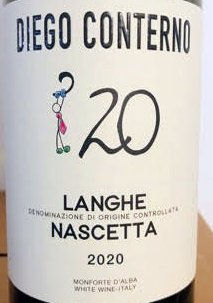 Diego Conterno Nascetta – Organic
Diego Conterno Nascetta – Organic
A rising star in the southern reaches of the Barolo zone, Diego Conterno and his son, Stefano, craft elegant wines in Monforte d’Alba, Baroli that are supple and utterly profound in their perfumes and flavors. They tend five acres in the heart of ‘Ginestra’ (plus another 15 acres in Monforte, including a rare plot of Nascetta vines) organically.
Trained by Piedmont legend Beppe Colla years ago at Prunotto, Diego with his cousins helped establish Conterno-Fantino in 1982. After nearly two decades of crafting bold wines at this modern Barolo estate, Diego felt it was time for him to explore a more natural expression of Nebbiolo.
He left the family project to start his own in 2000, bringing with him from his family’s holdings a nearly five-acre plot in ‘Ginestra,’ unquestionably Monforte’s top cru. In 2010, his son Stefano joined the estate, adding a new energy and focus to its already growing reputation for quality in Monforte.
Crucially, Diego Conterno wines “blend the energy and brawn of Monforte with the translucence of traditionally inspired winemaking,” says Antonio Galloni. Rich and potent yet utterly suave in perfume and flavor, wines across the board are made naturally, fermented on indigenous yeasts in neutral cement tanks and aged in traditional large oak cask (botti). All vines are cared for organically.
The estate tends some 20 acres of vineyard land organically in the village of Monforte d’Alba, located along the southern edge of the Barolo zone. The Conternos began farming organically in 2010, and achieved certification in 2014.
The family’s historical holdings include vines in the ‘Sori’ or full south-facing portion of ‘Ginestra,’ some five-acres worth and planted in 1982. Other holdings include vines in ‘San Pietro,’ ‘Pajana’ (part of Ginestra) and ‘Gris,’ all in Monforte.
The estate’s Nebbiolo vines (for its Nebbiolo d’Alba bottling) as well as its Barbera, Dolcetto and Nascetta vines, are planted in ‘Ferrione,’ which faces west and is situated just below the family winery, which was renovated in 2014.
Harvest is performed by hand. In the cellar, grapes are destemmed and fermented on indigenous yeasts in temperature-controlled, stainless steel tanks. Barolo wines are aged in traditional oak cask (botti), then further aged in neutral cement tanks before bottling, with very little added sulfur.
Piedmont’s true native, white grape may be Nascetta (say nass-CHET-ta), a rare gem that is slowly making a comeback in the Langhe region after being forgotten for too many years. Historically, Nascetta was made into a sweet wine (mostly for religious services) yet as a dry wine, its complexity and aromatic intensity are immediately captivating. Citrus and pineapple, savory notes of sage and rosemary.
 Moulin de la Roque Bandol Rosé Les Hauts de Vallon (Sustainable)
Moulin de la Roque Bandol Rosé Les Hauts de Vallon (Sustainable)
50% Mourvèdre, 40% Grenache, 10% Cinsault.
Founded in 1950 by the winegrowers of la Cadière d’Azur, St-Cyr-sur-Mer, and Sanary-sur-mer, the Moulin de La Roque cellar was initially designed for the oak barrel maturing of Bandol red wines. In 1964, through the efforts of the winegrowers and following numerous alterations, Moulin de La Roque became a wine production cellar for Bandol wines.
The Bandol produced each year at Moulin de La Roque is harvested, vinified, and matured with a constant eye to achieving quality excellence. Backed by its expertise and the latest equipment, the Moulin de La
Roque cellar also preserves the methods that have forged the reputation that Bandol wine enjoys today.
Looking out to the Mediterranean sea and surrounded by hills and mountains, the terroir of Bandol forms a veritable natural amphitheater. Bandol terroir has the advantage of enjoying a microclimate that favors the optimum ripening of its principal grape variety, Mourvèdre.
Soil: Red sand loaded with limestone pebbles Winemaking: Manual harvest grapes are destemmed to avoid harsh tannins. Grapes transferred to gentle pneumatic presses and the juice flows into temp-controlled stainless steel tanks. Following alcoholic fermentation, there is a lengthy vatting period of 20 to 30 days to allow the young wine to truly come into its own.
Terrific value in Bandol Rose’, widely considered the king of Provençal Rose’. This classic blend of Mourvedre, Grenache and Cinsault flows on a palate of Rainier cherry, nectarine and tangerine with good body, and finishes dry. Lovely aromas of wild herbs and coastal breeze round out this fabulous salmon-colored Rose’. This Bandol Rose’ shows depth and complexity and pairs well with salmon, soft Brie with olives or try with grilled lamb with rosemary.
92 points Wine Enthusiast: The perfumed, structured Mourvèdre casts its spell on this ripe, textured wine. Wild strawberry and spice flavors have a youthful bite of acidity and crispness, balanced by the intense fruitiness.
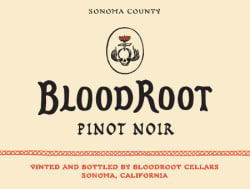 BloodRoot sonoma county Pinot Noir (Sustainable)
BloodRoot sonoma county Pinot Noir (Sustainable)
The spirit of BloodRoot is simple – make wines that reflect the soul of place, and make them at a quality and price level that make them absolute no-brainers to drink. Spearheaded by Noah and Kelly Dorrance of Reeve Wines, BloodRoot is a collaboration between esteemed winemakers with great vineyard sourcing who have come together to make masterful, value-minded wines.
The wines are sourced from multiple benchmark vineyards throughout California’s most respected wine-growing regions and reflect the soul of each place, creating wines that are timeless expressions of California’s dynamic terroir. 100% Pinot Noir from a blend of some of BloodRoot’s favorite vineyards across Sonoma County. A California Pinot through and through, this well-fruited wine is balanced by its grip and acidity.
Noah was the founding winemaker behind the wildly successful Banshee wines, and he takes that approach – great vineyards, varietally appropriate wines – to this project.
Like their Cabernet and Chardonnay, the Pinot punches well above its class, bringing great pleasure at a $25 price point.
The nose shows strawberries, blood orange, pomegranate, cola, and light oak spice. The palate is light with pretty red berry and oak spice and iron minerality to finish. Utilizing different fruit sources mostly throughout Sonoma County , the BloodRoot winemakers created a Pinot Noir blend that effortlessly melds cool, coastal Pinot elegance with the velvety polish of culty high-end Pinot producers. Twelve different vineyard sites were used to create this Sonoma County Pinot Noir. Harvest dates ranged from as early as September 3 all the way until October 10, which is very late for Pinot. The wine was fermented in small open-top vessels with hand punch downs daily.
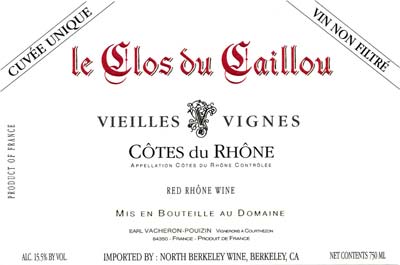 Clos de Caillou Côtes de Rhône VIEILLES VIGNES – Organic and biodynamic
Clos de Caillou Côtes de Rhône VIEILLES VIGNES – Organic and biodynamic
Wines from Le Clos du Caillou are Rhône blends at their most intense. Concentrated and richly textured, these organically raised, older-vine wines capture the spice and silk of old-vine Grenache grown on the region’s finest terroirs.
Each wine reflects the native perfumes of the south, the “garrigue” blend of thyme, rosemary and lavender that grows wild among the estate’s vines. Of all the terroir in the Côtes du Rhône appellation, the “clos” of Caillou has to be one of the most exceptional.
Completely surrounded by Châteauneuf-du-Pape vineyards, this walled parcel of land was intentionally left out of the appellation by the owner, following a bureaucratic spat back in 1936. What this means today is that Caillou’s Côtes du Rhône wines are qualitatively the same, with regard to terroir and exposition, as top Châteauneuf wines.
Caillou’s devotion to the character of the land (through bottling wines according to terroir) and its dedication to organic and biodynamic viticulture are what captivated us so many years ago when we first encountered these wines; and over the years, this fidelity to soil and soul has only intensified.
The estate in Courthézon, in the northeastern part of the Châteauneuf-du-Pape appellation, boasts a mix of terroirs with a predominance of sand, which gives Caillou wines their silky elegance and a fine-grained texture. Importantly, the “clos,” or walled portion of the estate where vines for Côtes du Rhône wines are grown, shares the same terroir with Caillou’s Châteauneuf-du-Pape vineyards.
The estate has been practicing biodynamic viticulture since 2003, and was certified organic as of 2010. Grapes are harvested by hand and manually sorted in both the fields and at the cellar, then partially destemmed and fermented on indigenous yeasts in cement tanks. Wines are aged in a combination of large foudre, demi-muid and barrel, depending on the wine and the vintage, for approximately 15 to 18 months in the estate’s cool underground cellars, and are bottled unfined and unfiltered.
82% Grenache and 18% Syrah from a mix of vineyards that share similar terroir to classic Châteauneuf-du-Pape vineyards: large, round quartz river stones (galets roulés), clay and sand. Vine age is 45 years, on average. The grapes are hand-harvested, and fermented on indigenous yeasts in temperature-controlled, stainless steel tanks. Aged for 16 months in 50% upright wooden tanks and 50% older large foudre . Bottled unfined and unfiltered.
Aromas of garrigue (wild thyme, lavender and rosemary). Flavors of raspberry and black cherry.

